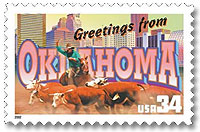
Worksheets and No Prep Teaching Resources
"You're Doing Fine, Oklahoma!"
 Worksheets and No Prep Teaching Resources |
"You're Doing Fine, Oklahoma!" |
| edHelper's suggested reading level: | grades 4 to 6 | |
| Flesch-Kincaid grade level: | 8.82 |
| Print "You're Doing Fine, Oklahoma!" (font options, pick words for additional puzzles, and more) |
|
| Quickly print reading comprehension |
|
| Print a proofreading activity |
| Leave your feedback on "You're Doing Fine, Oklahoma!" (use this link if you found an error in the story) |
|
"You're Doing Fine, Oklahoma!"
By Jayne Ann Williamson |

|
 1 The words from Rodgers and Hammerstein's musical Oklahoma! continue to ring true today. Our 46th state has a storied past worth retelling through the generations. Stories of hunters, explorers, settlers, and builders of modern cities all contribute to Oklahoma's rich history. The story reaches into the past more than 20,000 years ago and stretches far into the future.
1 The words from Rodgers and Hammerstein's musical Oklahoma! continue to ring true today. Our 46th state has a storied past worth retelling through the generations. Stories of hunters, explorers, settlers, and builders of modern cities all contribute to Oklahoma's rich history. The story reaches into the past more than 20,000 years ago and stretches far into the future.